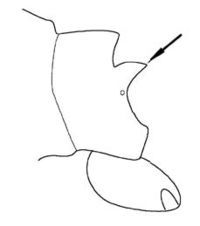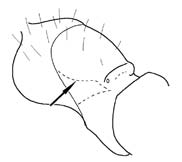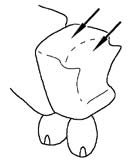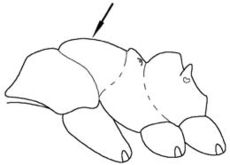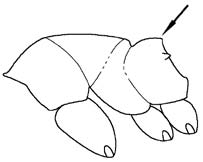Key to Stigmacros of the southwestern Australian Botanical Province
This worker key is based on: Heterick, B. E. 2009a. A guide to the ants of South-western Australia. Records of the Western Australian Museum, Supplement 76: 1-206. Part 2.
The key produced by McAreavey (1957) is, unfortunately, not easy to use, and may not reflect the outcome of a modern revision of the group; hence it has not been followed here.
You may also be interested in
1
- Dorsum of node with pair of spines directed posteriad (Figure 408) . . . . . 2
- Dorsum of node unarmed, or nearly so (may be divided into pair of blunt lobes or vestigial denticles) (Figure 409) . . . . . 6
2
return to couplet #1
- Propodeum armed with two pairs of stout spines; one pair at propodeal angles and one pair directly above propodeal spiracles, respectively (sub-genus Hagiostigmacros) (possibly two species represented here) (Figure 410) . . . . . Stigmacros spinosa
- Propodeum armed with one pair of spines or denticles directly above propodeal spiracles, propodeal angles produced as weak or vestigial denticles (Figure 411) . . . . . 3
3
return to couplet #2
- Head and mesosoma glossy black . . . . . Stigmacros brachytera (a few workers)
- Head and mesosoma yellow or reddish-brown . . . . . 4
4
return to couplet #3
- Process directly above propodeal spiracle a short denticle (Figure 412) . . . . . Stigmacros sp. JDM 832
- Process directly above propodeal spiracle a stout spine (Figure 413) . . . . . 5
5
return to couplet #4
- Yellow species; mesosoma and gaster with many erect setae, gaster also pubescent . . . . . Stigmacros sp. JDM 831
- Gaster and head brown, mesosoma and appendages light reddish brown; sparse erect setae present only on margins of gastral tergites and underside of gaster, gaster not pubescent . . . . . Stigmacros sp. JDM 622
6
return to couplet #1
- Gaster moderately to densely pubescent; cuticle of mesosoma microreticulate and usually matt, with many short, erect setae . . . . . 7
- Gaster, at most, with weak pubescence with appressed setulae normally sparse; cuticle of mesosoma often smooth, shining, rarely with erect setae (if present, these are normally long) . . . . . 9
7
return to couplet #6
- Black or dark brown species with orange or brownish appendages, petiolar node orange to black . . . . . Stigmacros sp. JDM 341
- Uniformly orange species . . . . . 8
8
return to couplet #7
- Propodeum with distinctly longitudinal impressed furrow; propodeal angles blunt (Figure 414); sculpture of head and mesosoma superficial, cuticle more-or-less shiny; pubescence on first gastral tergite dense . . . . . Stigmacros sp. JDM 396
- Propodeum without longitudinal furrow or furrow vestigial and barely discernible; propodeal angles denticulate (Figure 415); cuticle of head and mesosoma finely microreticulate; dull; shagreenate; pubescence on first gastral tergite moderate, with short, appressed setae visibly separate . . . . . Stigmacros sp. JDM 829
9
return to couplet #6
- Erect setae present on mesosoma; non-marginal, erect setae present on gastral tergites . . . . . 10
- Erect setae absent from mesosoma; if erect setae present on gaster, then confined to margins of tergites . . . . . 13
10
return to couplet #9
- Propodeum smoothly rounded without longitudinal furrow or lateral carinae (Figure 416) . . . . . Stigmacros sp. JDM 1046
- Propodeum laterally carinate, longitudinal furrow present or absent (Figure 417) . . . . . 11
11
return to couplet #10
- In profile, mesonotum convex, its dorsum smoothly rounded into its lateral surfaces (Figure 418) . . . . . Stigmacros inermis
- In profile, mesonotum flat, its dorsal and lateral surfaces distinct, often separated by a strong carina extending fully or partly along the length of the mesonotum (Figure 419) . . . . . 12
12
return to couplet #11
- In profile, dorsum of propodeum smoothly confluent with declivitous face; propodeal angle absent (Figure 420); erect setae present on all surfaces of mesosoma . . . . . Stigmacros pilosella
- In profile, dorsal and declivitous faces of propodeum distinct; propodeal angle present (Figure 421); erect setae virtually confined to pronotum (one or two short setae may be evident on mesonotum) . . . . . Stigmacros stanleyi
13
return to couplet #9
- In profile, pronotum and mesonotum flat and on same plane, or mesonotum weakly convex; mesonotum and often pronotum laterally carinate (Figure 422); ants bicoloured, head, mesosoma and gaster always black or shades of dark red-and-brown, appendages usually much lighter coloured, often yellow or orange. . . . . . 14
- In profile, pronotum and mesonotum weakly to strongly convex; pronotum never carinate, dorsum of mesonotum usually smoothly rounded onto sides (Figure 423), occasionally with weak angle between dorsal and lateral surfaces; species concolorous light yellow or orange or shades of brown without strong contrast between body and appendages . . . . . 19
14
return to couplet #13
- In dorsal view, head distinctly darker than mesosoma . . . . . 15
- In dorsal view, head same colour as, or slightly lighter than mesosoma . . . . . 16
15
return to couplet #14
- Propodeum with flat dorsal and declivitous faces, in profile, propodeal angle strong (Figure 424) . . . . . Stigmacros aemula
- Propodeum with a short dorsal face merging imperceptibly into a long, smooth, slightly concave declivitous face (Figure 425); in profile propodeal angle very weak . . . . . Stigmacros epinotalis
16
return to couplet #14
- In dorsal view, mesonotum with strong punctate-microreticulate sculpture, appearance dull . . . . . Stigmacros anthracina
- In dorsal view, mesonotum with very fine microreticulation or sculpture lacking, appearance shining . . . . . 17
17
return to couplet #16
- In profile, propodeum narrow, about 1/2 as wide as high, longitudinal furrow absent, propodeum with oblique outline (Figure 426); fine, microreticulate sculpture present on mesonotum . . . . . Stigmacros sp. JDM 1045
- In profile, propodeum about as wide as high; longitudinal furrow present, propodeum with outline of anterior lateral carinae rectangular or describing an arc in a horizontal plane (Figures 427, 428); mesonotal sculpture absent. . . . . . 18
18
return to couplet #17
- Eye large, its width ≥ width of fore tibia; in full-face view (Figure 429a); dorsum of node bilobate (Figure 429b) . . . . . Stigmacros elegans
- Eye smaller, its width < width of fore tibia (Figure 430a); in full-face view, dorsum of node straight or slightly concave, meeting the sides at an angle (Figure 430b) . . . . . Stigmacros brachytera (most workers)
19
return to couplet #13
- Head, mesosoma, node, gaster, most of femora and extreme end of antenna chocolate, tips of femora, tibiae, tarsi and most of antenna ochraceous . . . . . Stigmacros reticulata
- Appearance not as above . . . . . 20
20
return to couplet #19
- Mesonotum smooth and shining; in profile, weakly convex (Figure 431); head and mesosoma nearly always concolorous yellow or light orange . . . . . 21
- Mesonotum with distinct, though sometimes weak sculpture; in profile strongly convex (Figure 432); colour yellowish or brown, head often darker than mesosoma (S. occidentalis complex) . . . . . 24
21
return to couplet #20
- In profile, dorsum of propodeum rounded before it meets denticles directly above the spiracles (Figure 433) . . . . . Stigmacros sp. JDM 1050
- In profile, dorsum of propodeum angular or rectangular (S. pusilla complex) (Figure 434) . . . . . 22
22
return to couplet #21
- In profile, propodeal angles denticulate, directed upward (Figure 435); larger (HW > 0.5 mm) . . . . . Stigmacros pusilla
- In profile, propodeal angles not denticulate, directed laterally (Figure 436); smaller (HW < 0.5 mm) . . . . . 23
23
return to couplet #22
- Eye moderate (eye width ≈ 0.25 × width of side of head capsule) . . . . . Stigmacros sp. JDM 115
- Eye large (eye width < 1/3 × width of side of head capsule) . . . . . Stigmacros sp. JDM 188
24
return to couplet #20
- Pale yellowish species, head concolorous with mesosoma or only slightly darker . . . . . 25
- Brownish species, head usually distinctly darker than mesosoma . . . . . 28
25
return to couplet #24
- Node deeply bilobate, lateral processes distinct denticles . . . . . Stigmacros sp. JDM 1067
- Node not deeply bilobate, lateral processes vestigial or absent . . . . . 26
26
return to couplet #25
- Eye width moderate (eye width, at most, only fractionally greater than greatest width of scape) . . . . . Stigmacros flava
- Eye large (eye width ≥ 3 x greatest width of scape) . . . . . 27
27
return to couplet #26
- In dorsal view, mesonotum as long as wide; (Figure 437) . . . . . Stigmacros sp. JDM 1135
- In dorsal view, mesonotum 1.5 – 2 x as long as wide (Figure 438) . . . . . Stigmacros sp. JDM 443
28
return to couplet #24
- Eye large, ≈ 3 times as wide as antennal scape at its widest point . . . . . Stigmacros termitoxena
- Eye smaller, ≈ as wide as antennal scape at its widest point . . . . . 29
29
return to couplet #28
- Node with small but distinct lateral denticles (Figure 439) . . . . . Stigmacros occidentalis
- Node lacking lateral denticles (Figure 440) . . . . . Stigmacros glauerti









